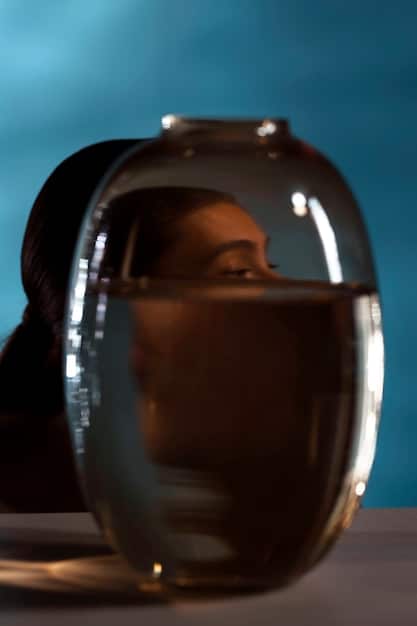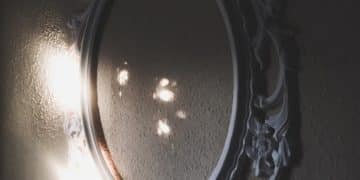Unveiling Scrying Techniques: A Comparative Review of Foundational Texts

Scrying Techniques Unveiled: A Comparative Review of Three Foundational Texts explores the core methods, historical context, and practical applications detailed in seminal works, offering insights into how these texts have shaped modern scrying practices.
Delve into the mystical world of scrying as we embark on Scrying Techniques Unveiled: A Comparative Review of Three Foundational Texts. Discover the historical roots and practical applications of this ancient divination practice, with a focus on key texts that have shaped its modern form. Prepare to peer into the depths of reflective surfaces and unlock hidden knowledge.
A Journey Through Scrying’s Literary Foundations
Scrying, the art of divination through gazing into reflective surfaces, boasts a rich history and a diverse range of techniques. To understand its enduring appeal, it’s essential to explore the foundational texts that have shaped its practice. This article offers a comparative review of three influential books that have laid the groundwork for modern scrying.
We will examine the core concepts, methodologies, and historical contexts of each text, providing insights into their unique contributions to the art of scrying. By comparing these works, we aim to offer a comprehensive understanding of the principles and practices that underpin this ancient divination technique.

“Crystal Vision Through Crystal Gazing” by Frater Achad: Illuminating the Path
Frater Achad’s “Crystal Vision Through Crystal Gazing” is a cornerstone text in the realm of scrying. Published in the early 20th century, it offers a detailed exploration of crystal gazing as a means of spiritual development and accessing hidden knowledge. Achad’s unique perspective and practical exercises have made this book a valuable resource for both beginners and experienced practitioners.
Achad, a prominent figure in the Ordo Templi Orientis (OTO), brought a distinct blend of Thelemic philosophy and practical magic to his work. His approach to crystal gazing emphasizes the importance of cultivating a receptive state of mind and developing the ability to interpret the symbolic language of the visions that appear.
Achad’s Methodology: Preparing the Mind and the Crystal
Achad outlines a specific methodology for preparing both the mind and the crystal before engaging in scrying. This includes techniques for relaxation, visualization, and creating a sacred space conducive to divination. He stresses the importance of intention and focusing one’s will on the desired outcome.
The book also provides detailed instructions on selecting and consecrating a crystal ball, as well as techniques for cleansing and charging it with energy. Achad emphasizes the personal connection between the scryer and the crystal, viewing it as a tool for amplifying one’s inner vision.
- Mental Preparation: Achad details specific meditation techniques to calm the mind and enhance focus.
- Crystal Consecration: He provides a ritual for dedicating the crystal to the scrying practice.
- Symbolic Interpretation: Achad offers guidance on understanding the symbolism encountered in visions.
- Ethical Considerations: The text emphasizes the importance of using scrying responsibly and ethically.
Ultimately, “Crystal Vision Through Crystal Gazing” offers a comprehensive and practical guide to crystal gazing, rooted in the rich traditions of Western esotericism. Achad’s emphasis on personal development and ethical practice makes this book a valuable resource for anyone seeking to explore the depths of their inner vision.
“The Art of Scrying” by Amber Grant: A Modern Perspective
Amber Grant’s “The Art of Scrying” offers a contemporary approach to this ancient practice, blending traditional techniques with modern insights. This comprehensive guide covers a wide range of scrying methods, from crystal gazing to water scrying, providing practical advice and exercises for developing one’s scrying abilities.
Grant emphasizes the importance of personal experimentation and finding the scrying method that resonates best with the individual practitioner. She encourages readers to trust their intuition and develop their own unique approach to interpreting the visions that appear.
Exploring Diverse Scrying Methods
Grant’s book explores a wide array of scrying techniques, each with its unique advantages and challenges. She provides detailed instructions on how to set up and perform each method, as well as tips for troubleshooting common difficulties. These methods include:
- Crystal Gazing: Using a crystal ball to induce visions.
- Water Scrying: Gazing into a bowl of water to receive messages.
- Mirror Scrying: Employing a dark mirror to access subconscious imagery.
- Fire Scrying: Focusing on the flames of a fire to discern hidden truths.
“The Art of Scrying” approaches scrying as an accessible skill rather than an innate talent and suggests readers should embrace experimentation to find the best method for them. Trusting intuition is key to accurately interpreting the symbols seen during scrying, and Grant provides multiple exercises to help enhance this ability.
Water scrying is one of the simplest techniques. It requires only a dark bowl or container filled with water. The user looks deeply into the water, relaxing their eyes until images start to emerge on the water’s surface. Grant also covers mirror scrying which employs a darkened mirror to stimulate the subconscious. Fire scrying uses the flickering flames of candle or campfire to reveal images or messages. All methods emphasize the element of environmental preparation and mental focus to induce a receptive state for divination.

“Practical Guide to Creative Visualization” by Denning and Phillips: The Power of the Mind
While not solely focused on scrying, “Practical Guide to Creative Visualization” by Denning and Phillips is a fundamental text that provides the essential mental and visualization techniques used in scrying practices. This book emphasizes the power of the mind to create and manifest reality, offering practical exercises for developing one’s visualization abilities.
Denning and Phillips, well-respected figures in the modern occult movement, present a comprehensive system of visualization techniques rooted in the Golden Dawn tradition. Their approach emphasizes the importance of clear and focused mental imagery, as well as the use of affirmations and emotional engagement to enhance the effectiveness of visualizations.
The Role of Visualization in Scrying
Visualization is a crucial component of scrying, as it allows the practitioner to create the mental space and imagery necessary to receive visions. Denning and Phillips provide a step-by-step guide to developing effective visualization techniques, including:
- Sensory Awareness: Engaging all five senses to create vivid and realistic mental images.
- Emotional Connection: Infusing visualizations with emotion to enhance their power.
- Affirmations: Using positive statements to reinforce desired outcomes.
- Mental Projection: Projecting one’s consciousness into the visualized scene.
The ability to enter a focused, meditative state is key for successful scrying, and this book gives specific drills and exercises for developing that skill. By learning how to consciously shape the inner world, one can effectively direct their scrying attempts.
The authors view creative visualization as a method of actively shaping one’s reality, aligning inner thoughts with outward manifestations. While they do not focus on scrying specifically, the techniques provided are deeply applicable to scrying practices. With regular use of visualization techniques, the scryer is able to create a symbolic and receptive space for connecting with deeper insights and messages from the subconscious.
Comparative Analysis: Bridging the Texts
While each of these texts offers a unique perspective on scrying, they share several common themes and principles. All three emphasize the importance of mental preparation, focused intention, and cultivating a receptive state of mind. They also highlight the significance of symbolic interpretation and trusting one’s intuition.
By comparing these texts, we can gain a deeper understanding of the core principles that underpin scrying and develop a more nuanced approach to its practice. Each book complements the others, providing a well-rounded foundation for exploring the mystical art of divination through gazing.
Modern Scrying: Beyond the Books
Today, scrying continues to evolve, influenced by both traditional methods and modern technologies. Many practitioners incorporate new tools and techniques into their practice, such as digital screens, holographic images, and virtual reality environments.
Despite these advancements, the core principles of scrying remain the same: cultivating a receptive state of mind, focusing one’s intention, and trusting the symbolic language of the visions that appear. Whether using a crystal ball or a digital screen, the art of scrying ultimately lies in the practitioner’s ability to connect with their inner wisdom and tap into the hidden realms of consciousness.
The Enduring Appeal of Scrying
Scrying’s enduring appeal lies in its ability to provide a direct and personal connection to the unknown. By gazing into reflective surfaces, practitioners can access subconscious imagery, receive guidance from spiritual entities, and gain insights into their own lives and the world around them.
Whether viewed as a form of divination, a tool for self-discovery, or a means of spiritual exploration, scrying continues to captivate and inspire those who seek to unlock the mysteries of the universe and the depths of the human psyche.
| Key Point | Brief Description |
|---|---|
| 🔮 Crystal Gazing | Using a crystal ball as a focal point for inducing visions. |
| 💧 Water Scrying | Gazing into water to receive psychic messages and insights. |
| 🔥 Fire Scrying | Focusing on flames to discern truths and predict future events. |
| 🪞 Mirror Scrying | Employing a dark mirror to connect with the subconscious. |
Frequently Asked Questions
▼
Scrying is a divination technique involving gazing into a reflective surface to receive visions or insights. It’s used for seeking guidance, exploring the subconscious, predicting future events, and gaining spiritual understanding.
▼
Popular reflective surfaces include crystal balls, dark mirrors, bowls of water, and even polished stones. The best surface is one that resonates with the practitioner and allows for clear, focused gazing.
▼
Preparation involves creating a calm and focused environment, cleansing the chosen reflective surface, and setting a clear intention for the session. Meditation and relaxation techniques can also be beneficial.
▼
Visions are often symbolic and require interpretation. Meanings can be personal and influenced by the scryer’s subconscious and cultural background. Keeping a journal to track visions and their outcomes can help refine interpretation skills.
▼
Scrying is generally safe, but it’s important to approach it with respect and ethical considerations. Grounding oneself after a session is advisable, and it’s crucial to use the insights gained responsibly and avoid using scrying to harm others.
Conclusion
Exploring the foundational texts of scrying unveils a rich tapestry of techniques and philosophies, each offering unique pathways to self-discovery and divination. From Achad’s emphasis on mental preparation to Grant’s comprehensive exploration of various scrying methods, and Denning and Phillips application of visualization, these books provide invaluable tools for both novice and experienced practitioners seeking to unlock the hidden realms within and without. By understanding the core principles outlined in these influential works, you can embark on your own transformative journey into the art of scrying.





